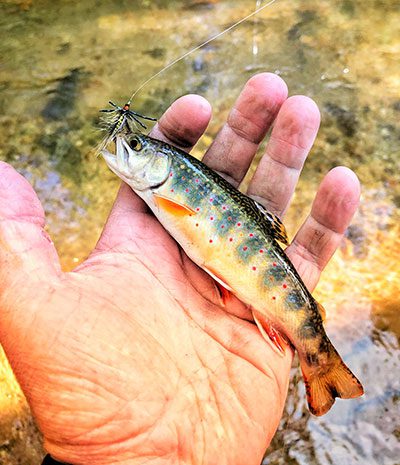Blue Lining for wild trout is out of this world. The term “Blue Lining” is becoming more mainstream, and four-wheel drive is recommended along with a good pair of hiking boots. As for Blue Lining, I am not quite sure how the term came about, but, it’s simply fishing tiny water that is remote enough to be mostly left untouched, for a chance at catching a trout that has never been caught before.
The most common and well-known trout fishing waters in the Southeast are all stocked streams and lakes. Summertime tailwaters and wintertime delayed harvest provide a year round fishery, but they almost always exclude native fish. Named waters do contain decent numbers of wild fish; to clarify, wild and native fish are different. Wild fish would be reproducing brown, rainbow, and brook trout. A true, native brook trout would be one that was not introduced to its environment by stocking, rather reproduced naturally in its waters. Comparatively, if one of each was held in the hands, one would easily be capable of telling the difference. Native brooks have vibrant colors and sport a great fight on the end of the line. The best part about native fish is, even though they sound elusive, they’ll be abundant once found. The fish common in Blue Line waters are five to ten inches long, with a trophy being over twelve inches.
What do I mean by “Blue Line”? To find Blue Lining water, choose almost any well-known waterway and find its source (the feeder creeks and springs). The farther off the beaten path, the better. My rule of thumb is, if the waterway has a name on Google Maps, it’s probably too big and has too much traffic. Search for the creeks on Google you see as an unnamed blue line but you can’t see water in satellite view because of the tree cover.
Finding the water in person should be just as challenging. Park on a gravel road and hike through a hardwood thicket. Remember, the area just out of view or over the next hill probably holds the fish hiding that have never seen a fly before.
When Blue Lining, the key to these small streams is presentation. Fly selection isn’t critical, and one of my go-to setups is a small chubby or dry fly with a 18-22 single nymph dropper. I run a shorter 3-5 wt. rod around seven and a half feet. You should never have to do anything other than a small roll cast or flip of the rod to get your fly in the perfect position. Make sure your fly has a natural presentation. I will give one word of caution; don’t spook the fish. Native and wild trout aren’t used to people trampling around them, and they do spook easily. Camouflage clothing and even hiding behind a tree make life easier.
The last thing to impart is my personal secret of how to find untouched waters. More than ever, people are exploring the outdoors, making untouched streams harder and harder to find. Being an avid kayaker, I use my Nucanoe to hit tiny tributaries miles from the closest road while floating some of the biggest named rivers in the state. To name a few, the Toccoa has hundreds alone along with the Nottely, Chattahoochee and any other river in the northernmost part of the state.
William Reed is a Nucanoe National Pro Staff Writer. You can contact him at will@nucanoe.com or find him on InstaGram @wde_will.
